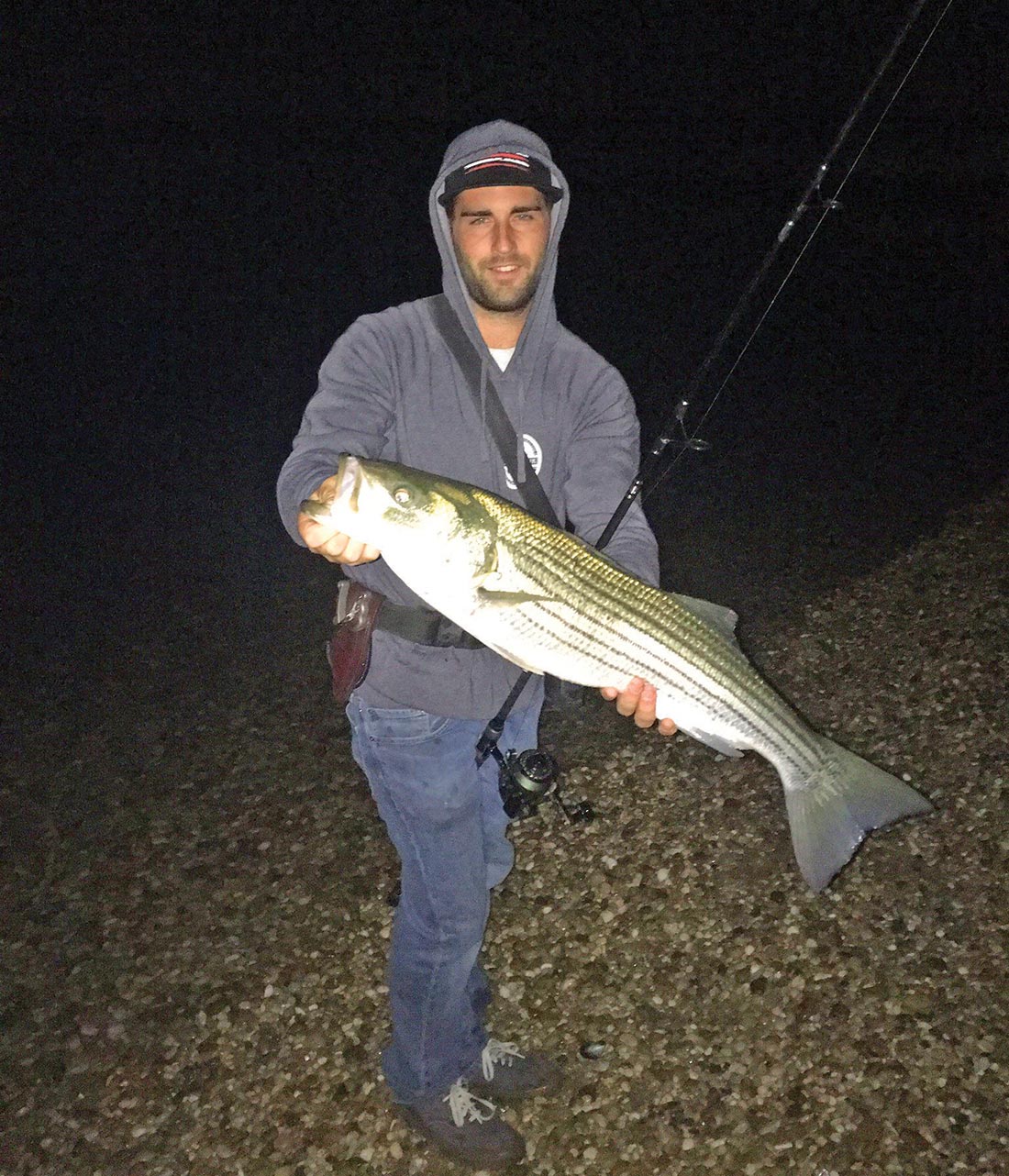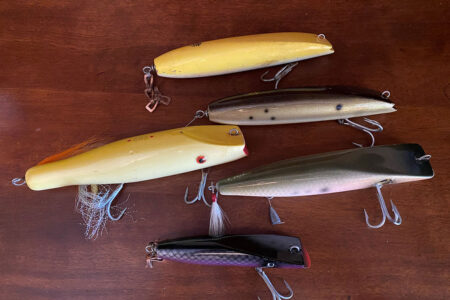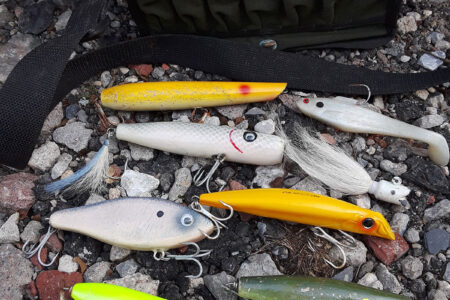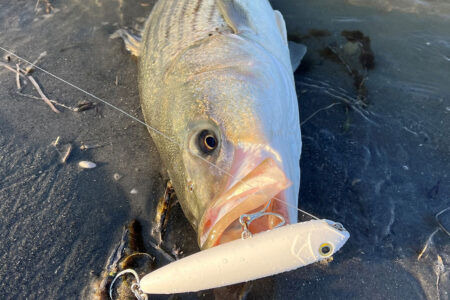You want your plug to look like a baitfish caught in the current and swinging naturally into fish holding structure.
It was late October in 2016, two friends and I were walking the sand to a big point at the mouth of a shallow inlet. I had enjoyed great success the past two weeks at this point, with a lot of fish in the mid 20-pound range. We got down there with the tide about two hours down and pushing out pretty hard. There was little to no wind and the moon was about a week off the full. The rip coming off the point looked great with a lot of hard water. A Bob Hahn metal lip had been floating around in my bag for a few days but I hadn’t actually thrown it in years. So what the hell – I tied it on. For those wondering, yes I tie direct, I hate clips. I make a cast straight ahead to see how the current is going to push my plug. The next cast is up tide at 2 o’clock. I get tight to the plug and it starts to swim in the current. The current there was strong and I didn’t have to reel much to get it to swim. In fact, I was almost not reeling at all. It swung to about 12 o’clock and I got slammed. A small fish but a good sign for what was in store for me on this night. I proceeded to land seven or eight fish in the low 20-pound class. Unfortunately, my friends all struggled, landing one small fish each. I was thinking that my metal lip was riding higher in the water column than any of the plugs my friends had in their bag. But the last fish I had, the biggest one, was on a Northbar bottle darter. This plug digs far deeper than the Bob Hahn I had on.
 Upon finishing the night, me and my friend Kevin rehashed the night as we always do, discussing the good, bad, and indifferent of the outing. We both attributed my success to my technique and the way I was swinging my plug. While I had always swung my lures through rips and structure the same way all the time, this night particularly made me start to think about my technique in further detail.
Upon finishing the night, me and my friend Kevin rehashed the night as we always do, discussing the good, bad, and indifferent of the outing. We both attributed my success to my technique and the way I was swinging my plug. While I had always swung my lures through rips and structure the same way all the time, this night particularly made me start to think about my technique in further detail.
When it comes to targeting striped bass, water current is essential. It allows bass to lurk behind boulders, shadow lines, and other pieces of structure to make an easy meal out of any prey being swept along by the current. In instances where you find current you may also find a rip. Working rips can provide some of the most rewarding fishing the beach has to offer. But finding a rip or piece of structure is the easiest part of all of this. Swinging your plug or jig through it and effectively presenting your lure is the most difficult, yet, it’s the most important.
It’s very easy to walk along the rocky beaches in Montauk and find rips and rock piles. Most of them will hold fish but that’s not to say you’ll catch them. A place like Montauk provides a lot of structure for bass to lay in wait for prey to get swept by, which provides a great opportunity for anglers. The south side rocks provide miles of boulder fields and plenty of current and rips to swing a plug through. When swinging a plug through current I like to work my plug as slowly as I can while still getting it to swim. While using a jig, I like to reel as slowly as I can without the jig dragging bottom. When there is a lot of current you don’t have to reel nearly as fast compared to fishing with little or no current. The current will work the plug or jig for you. The biggest mistake I see when fishing places with strong current is guys reeling too fast. The rip at Democrat Point is a place where you can work a plug and almost not reel at all. But again, I find a lot of guys don’t connect because their lure is moving too quickly.
Getting your plug to swing into a rip or piece of structure properly is one of the most important things to do when fishing for bass. Which leads me to the second biggest mistake I see when fishing a rip or piece of structure with high current. I see many guys cast directly into a rip or directly at structure. Baitfish don’t normally plop right on a bass’s head, so naturally your plug shouldn’t either. When you come across a rip or piece of structure you want your plug to naturally swing over it. Cast up tide and start working the plug in a fashion that the current will just naturally swing the plug or jig in front of the structure or into the rip. Your plug will resemble a baitfish that is caught in the current and is an easy meal for any bass set up in a rip. Bridges and shadow lines work the same way. You want your plug to look like a baitfish caught in the current and naturally swinging past a piling or into a shadow line.
Long Island’s South Shore is full of areas with current, rips, bridges, and other prime pieces of structure that will hold bass. Putting the time in and understanding where a bass will eat your lure will give you a better idea of how it needs to swing into that feeding zone. I have found most of my bites come between 11 and 1. So depending on where I’m fishing and how hard the tide is pushing, I’ll try to swing my lure between 10 and 2. If it’s slower than normal, I’ll just shorten my swing and keep the plug in the strike zone for the most amount of time.
Speed of current and water depth will tell me exactly what I can and can’t throw effectively. If the current is pushing too fast, you can’t get a plug to effectively swim while it’s in the strike zone. The current will just sweep the plug down tide before you can make any real contact with it, and this is when I’ll switch over and start swinging a bucktail or swim shad. Inlets are a prime example of this. The current in an inlet can provide excellent fishing for those who have learned how to work deep, fast, moving water. Bucktails and swim shads account for most of the big fish taken from Long Island’s inlets. This is because you can cast these lures way up tide and just reel fast enough to maintain contact with it and they don’t lose any action like a plug might as it gets washed passed you. Again, the strength of the tide will determine how heavy of a jig you will need, but “the swing” of your lure should remain virtually the same. Cast at 10 or 2 depending on current direction, and let your jig swing through the strike zone. Ideally the jig will ride just above the bottom as it swings between 10 and 2 so you will have to determine what weight bucktail you will need for that particular situation. As mentioned before, you want the jig to swing through your strike zone just above the bottom, not dragging on it.
All of this comes with experience and time on the water. Every rip and piece of structure is different and sometimes tactics need to be tweaked during an outing to get a bite. Don’t be afraid to try different things to find what really works for you. For the waters I fish, the tactics I’ve outlined have improved my success rate and continue to do so to this day. That being said, every spot will have its quirks and unique qualities so putting the time in and learning the ins and outs of a spot will allow you to zero in on a successful swing.



